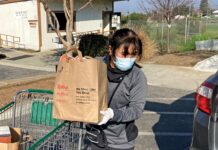”
I never got a T-shirt.
”
That thought suddenly hit me as I waited with 40 or so other
people for our San Jose State University history tour to begin.
“I never got a T-shirt.” That thought suddenly hit me as I waited with 40 or so other people for our San Jose State University history tour to begin.
As we stood in the entrance lobby at the campus’s Martin Luther King Jr. Public Library, I noticed that many other tour-taking alumni wore SJSU T-shirts and sweatshirts of blue and gold. That’s when I realized that during all my three years at SJSU, I never once bought its souvenir apparel.
I hadn’t planned on attending SJSU’s 150th Founders Day celebration May 4. But that Friday morning I read an editorial about it. I was going to be in San Jose for some business anyway, so I figured I’d come up early for the 10am campus history tour and maybe learn a new fact or two about my old alma mater.
Sprinkles of rain dropped as we wandered the SJSU grounds. But that didn’t discourage us in our pursuit of the university’s yesteryears as we learned about the people who’ve walked along the campus’s paths. Many of SJSU’s more famous folks helped transform the world.
The first, no doubt, was George W. Minns, who came via Cape Horn to San Francisco in 1854. Three years later, he started night classes to educate young women to work as teachers. Minn’s Evening Normal School planted the seed for SJSU. On May 2, 1862, Sacramento legislatures officially turned his institute into the California State Normal School. In 1871, the school moved to Washington Square in the village of San Jose where it’s been located since. It served as the cornerstone of the California State University system, which eventually grew, with 22 campuses, into the largest university system in the United States.
After learning about Minn, our group wandered inside Tower Hall. Inside its Morris Daly Auditorium, our guide told us about the celebrated people who have spoken there. I remembered the hellishly hard auditorium seats that tortured many student butts during long lectures. I recalled spending evenings here listening to such illustrious literary illuminati as Ray Bradbury, Amy Tan and Arthur Miller (all highly entertaining speakers), and William Styron (whose “reading” from his depressing essay on his suicide attempt was pure agony).
Continuing our tour, we came upon a bronze plaque on Tower Hall’s outside wall. It memorializes poet Edwin Markham who graduated from the state normal school in 1872. Little known now, Markham was a wordsmith widely celebrated in early 20th-century America. His poem “The Man with the Hoe” was a literary success that gained him much national fame. More importantly, his literary creation inspired people to consider the plight of exploited farm workers.
Strolling behind Tower Hall, we passed near a relatively new campus monument, a lawn sculpture showing two larger-than-life figures – John Carlos and Tommy Smith – with heads bowed and gloved fists raised proudly in the air. The two SJSU track athletes participated in the 1968 Olympic games in Mexico. Their controversial “black power salute” on the victory stand was a civil rights-era gesture protesting racism against oppressed people. Called “the Silent Protest,” that historic incident has been voted the sixth most memorial television event of the 20th Century.
Besides civil rights, SJSU has also played a role in America’s environmental movement. Graduate Gaylord Nelson went on to enjoy a career as a U.S. Senator from Wisconsin. He, along with then Bay Area Congressman Pete McCloskey, initiated the first “Earth Day” event in 1970.
As we stopped at a campus intersection, one man in our group recalled how he and other SJSU students protested environmental exploitation on that inaugural Earth Day. They buried a brand-new Ford gas-guzzler at that location where we stood. But the symbolic “Save the Environment” gesture actually turned out to be bad news for SJSU’s environment. Oil from the car’s engine leaked into the ground, so students dug the vehicle out several months later.
During my SJSU days, I never truly appreciated its world-changing history. Back then, I focused on hitting the books and working two or three jobs during the semesters. And, I’m deeply ashamed to admit, I never once got an SJSU T-shirt.
That fact quickly changed following the tour. That afternoon on the lawn in front of Tower Hall, along with a slice of cake handed out to all who attended the 150th birthday bash, I picked up a free commemorative T-shirt. Its logo reads: “SJSU: where tradition meets tomorrow.” I’ll wear it proudly.













